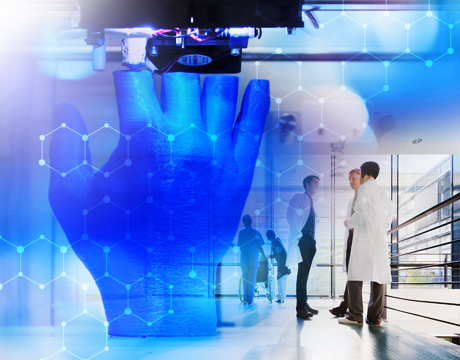Ever since 1980 the first 3D printer prototype was manufactured, the Additive Manufacturing (AM) industry developed a lot and is expected to keep growing (McCue, 2015). However, it was not until 2004 that an open source project was initiated which further accelerated the product development of the 3D printer. From there on 3D printing technology was enhanced radically. In the early days the 3D printers would only print one material (e.g. plastic) objects, but nowadays much more is possible. Especially 3D printing developments in the healthcare industry are having a major impact on healthcare quality and medical treatment costs. In the 1990’s medical researchers first started to use 3D printing for medical purposes which would change many lives in the future (Bensoussan, 2016). In this blog, multiple examples of how the 3D printing industry saves lives and changed the medical field are discussed.
Improvement of medical treatments by use of 3D printed models.
In a recent article (Giges, 2017) Dr. Justin Ryan, a biomedical engineer and research scientist at Phoenix Children’s Hospital’s Cardiac 3D Print Lab argued for the improvement of medical treatments by using 3D printed body parts. It is stressed that an increased amount of hospitals are accepting the 3D print technology and placing 3D printers in their hospitals. This adaption enables doctors to print out patient-specific body parts which are then used as a study material to increase medical operation success. Moreover, students can also practice and learn how to operate without putting the patient in danger. Dr. Philipp Brantner a radiologist at the University Hospital of Basel also emphasized the fact that 3D printers can have major impacts on healthcare and that is one of the success criteria to stay innovative and successful as a hospital (Sambaer, 2017). Moreover, by printing out a heart, a surgeon can study the model and discuss his opinion with a radiologist for the right course of action. Eventually, Ryan (Giges,2017) argued that this will decrease surgery time, anesthesia time and moreover, time that the heart is exposed to risk, which would accordingly decrease morbidity and mortality rates.
Lots of children in this world are born without one or more limbs, the development and placement of prostheses can cost up to 100.000 US dollar (MacRae, 2016), which is out of the budgets insurers set and out of scope for most lower class families. A more affordable solution is to print a limb (e.g. A hand) that fits the patient’s body. E-Nable is a community of volunteer engineers, 3D specialist, students and medical professionals that provide prosthetics to children without hands. Volunteers use their 3D designing and medical skills to design and use their 3D printers to make a difference for most children but also adults by providing them with a free or really affordable prosthesis.
Moreover, the above examples give some in-depth information on 3D prints used in healthcare, but much more is already possible. For example, skin replacement for burn victims, jaw replacement, knee replacement, airway splints for infants, hearing-aid shells, dental crowns and much more 3D-printed products are used on a daily base in healthcare. Hospitals started with the of use simple printed products. However, with more investments, time and research, more complex medical challenges are being taken to improve healthcare by 3D printing technology.
A future prediction is that already low-manufacturing costs will decrease even more (Hendricks, 2017). Additionally, printing of bio-based materials for human organs will improve but, the biggest challenge is finding a software that is innovative and advanced enough to meet the challenges of the designing process (Erin, 2017). The creation of so-called blueprints, which are digital models such a heart of liver model, remain a big challenge. They are far more complicated and complex to creates compared to for example the digital creation of a kneecap.
McCue, T. (2015, July 30). $4.1 Billion Industry Forecast In Crazy 3D Printing Stock Market. Retrieved October 15, 2017, from https://www.forbes.com/sites/tjmccue/2015/07/30/4-1-billion-industry-forecast-in-crazy-3d-printing-stock-market/#73ad2cba1631
Hendricks, D. (2017, May 18). 3D Printing Is Already Changing Health Care. Retrieved October 15, 2017, from https://hbr.org/2016/03/3d-printing-is-already-changing-health-car
Erin, A. (2015, March 20). 7 Major Advancements 3D Printing Is Making in the Medical Field. Retrieved October 15, 2017, from http://thefutureofthings.com/8973-7-major-advancements-3d-printing-is-making-in-the-medical-field/
Giges, N. (2017, May). Top 5 Ways 3D Printing Is Changing the Medical Field. Retrieved October 15, 2017, from https://www.asme.org/engineering-topics/articles/manufacturing-design/top-5-ways-3d-printing-changing-medical-field
Sambaer, M. (2017, July 18). Hospital 3D printing lab. Retrieved October 15, 2017, from http://www.materialise.com/en/blog/hospital-3d-printing-lab
MacRae, M. (2016, January). Reaching Out with 3D Printed Hands. Retrieved October 15, 2017, from https://www.asme.org/engineering-topics/articles/bioengineering/reaching-with-3d-printed-hands

